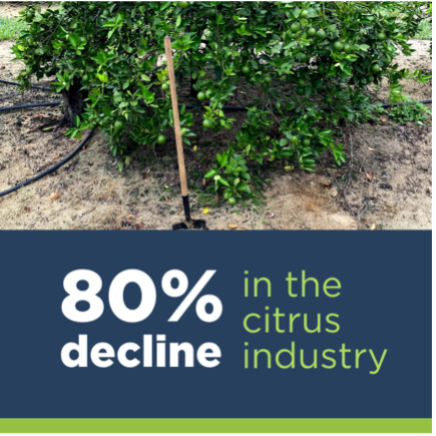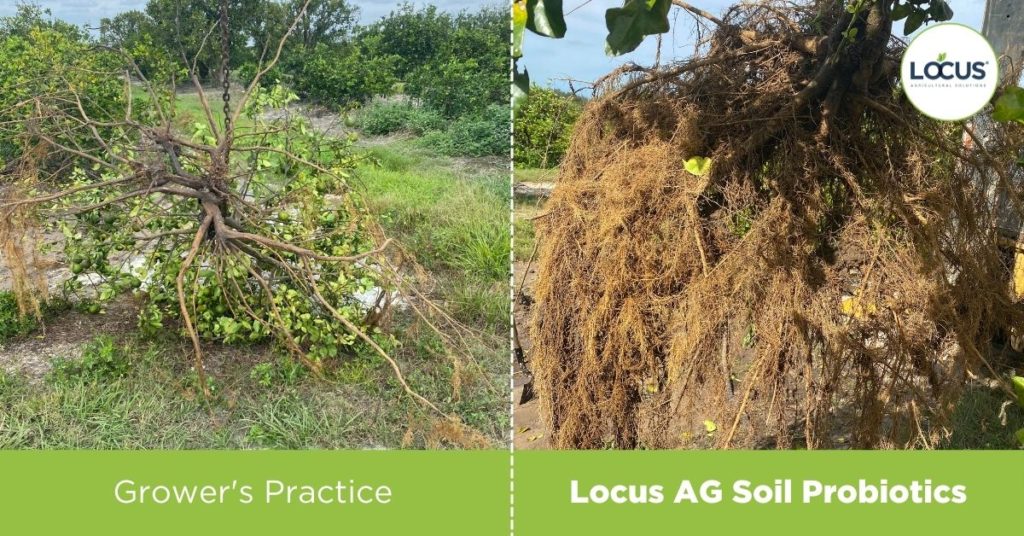
Citrus Greening Battle Finds Powerful Ally in Biologicals
Locus AG biologicals build back a robust root system and improve fruit quality in HLB-damaged citrus trees.
 Citrus greening, or Huanglongbing (HLB) disease, is a very real problem occurring right now in the Florida citrus industry. Spread through a tiny insect no larger than 3 mm long, HLB decreases water and nutrient uptake in affected trees and causes tree roots to die. This disease has wreaked havoc on citrus groves in Florida over the past 15 years, causing a devastating 80% decline in production in the Florida citrus industry. Little has been found to successfully reverse the damage of HLB, which has left generations of Florida citrus growers distraught over the future of their family groves.
Citrus greening, or Huanglongbing (HLB) disease, is a very real problem occurring right now in the Florida citrus industry. Spread through a tiny insect no larger than 3 mm long, HLB decreases water and nutrient uptake in affected trees and causes tree roots to die. This disease has wreaked havoc on citrus groves in Florida over the past 15 years, causing a devastating 80% decline in production in the Florida citrus industry. Little has been found to successfully reverse the damage of HLB, which has left generations of Florida citrus growers distraught over the future of their family groves.
Yet, in very recent years, some farmers have found a way to battle this insidious disease through a tiny army made up of soil microbes.
In this blog, learn more about:
- Citrus Greening Disease
- How Agricultural Biologicals Can Help Combat Citrus Greening
- Results of Biologicals in Citrus Trees
- Hope for the Future of Citrus
What is Citrus Greening Disease?
Citrus greening is spread from tree to tree by the Asian citrus psyllid, an invasive species of insect first detected in Florida in 1998. This disease damages and eventually kills citrus trees by attacking the tree’s vascular system, which drastically limits its nutrient intake. Visible signs of the disease include reduced yield, fruit size and quality. Once a tree is infected, it increases the chances of early mortality. These factors subsequently increase production costs. 
Another sign of citrus greening disease not as visible as its effects on the leaves and fruit, hidden underground, is a decreased root mass caused by root dieback. Fewer roots mean a reduction in the amount of water and nutrients the citrus tree can access and utilize, exacerbating the problems associated with HLB.
How Widespread is the Severity of Citrus Greening Disease?
According to experts at the University of Florida, citrus greening has caused a statewide decline of 80% over the past 15 years in Florida citrus groves, while production costs have risen an average of 75% during that same period.
On average, the current percentage of HLB-infected acres and trees in a citrus operation in Florida are 90% and 80% respectively. And the 2021-2022 harvest is projected to be the worst in 75 years. However, this problem is not confined to Florida groves but is spreading throughout other growing areas across the United States. Citrus greening disease has been detected in Louisiana, South Carolina, Texas and Georgia. Scientists have detected the disease in California, which grows 80% of this country’s fresh citrus fruit (compared to the primary output in Florida of oranges for juice) and represents $3.4 billion in citrus trees.
Universities are collaborating on research to combat citrus greening disease, but as one scientist at UC Davis said, there is no single magic bullet to cure it.
How Do Agricultural Biologicals Help to Combat Citrus Greening?
While no single method has yet been discovered that can cure HLB, some citrus growers in Florida have found a practical and powerful tool to help combat the effects of citrus greening: agricultural biologicals.
Developed by Locus Agriculture® (Locus AG), these biologicals are produced through a fermentation process, yielding a non-GMO biological that is beneficial to the soil and gentle on the environment. These naturally occurring microbial soil amendments, comprised of specifically selected active strains, are tailored to colonize roots and promote early root development.
Biologicals pose one of the only known ways to encourage new root growth on previously dying or dead root systems suffering from HLB. These biologicals enhance nutrient solubilization and uptake, thereby reducing runoff, and enable trees to better protect against abiotic and biotic stressors. In fact, several universities in California and Florida, working in collaboration, are focused specifically on the relationship between a healthy soil microbiome, root health and HLB mitigation. Researchers specify that a healthier root system provides one strategy to help “sustain orchard longevity” in groves impacted by HLB.
READ MORE: Locus AG’s Product Line of Agricultural Biologicals
Biological Results in Citrus Trees

Image shows two Florida citrus trees impacted by citrus greening. The image on the left shows weak roots and significant die-back. The image on the right shows robust root system regrowth, with lots of feeder roots, due to the use of Locus AG biologicals over a one-year span of time.
Florida citrus growers who have treated HLB-diseased citrus trees with Locus AG biologicals have found that, in as little as 30 days, the treated citrus trees show significantly more and stronger root systems compared to the growers’ standard practices. The increase is particularly illustrated by a greater mass of feeder roots, providing greater opportunities and surface area for both nutrient and water uptake from the soil.
In one grove, trees were dug up to fully evaluate the root growth from use of Locus AG’s biologicals.
On average, growers witnessed a 77% increase in root mass, with similar results seen across HLB-impacted trees throughout multiple commercial groves in Florida.
Other issues related to HLB and root die back are canopy size and fruit drop. A healthy tree with a robust root system allows for efficient nutrient and water uptake. This means that the tree can spend its energy on creating lush canopies, which in turn means more citrus fruit. In addition to sheer quantity, a healthier citrus tree can hold onto its fruit longer, meaning less fruit drop and larger fruit size.
Growers treating with Locus AG biologicals are seeing larger fruit sizes, better fruit quality and less fruit drop.
Is There Hope for the Future?
Citrus trees experience slower growth compared to other types of crops. It takes more time for changes below ground in the soil to show up in the fruit itself, in comparison to row crops.
In addition, replacing diseased trees is expensive and time consuming.
Locus AG biologicals are helping infected trees build a more robust root system, which allows them to put energy into the basics of regrowing what was lost to HLB. Locus AG agronomists believe this will have a positive impact on years to come. Because if this year, the tree builds feeder root mass and retains its leaves, that means next year the tree can put that same energy into the fruit.
Interested in trying biologicals at your citrus grove? Contact us below.
Want to learn how Locus AG vital biologicals can increase your yields and profits?
Fill out the form below and one of our agricultural experts will be in touch.


